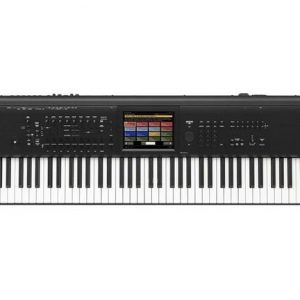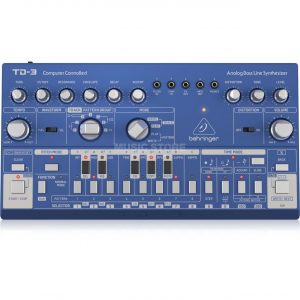Arturia MiniBrute 2
$264.99
Check out the Arturia MiniBrute 2, the ultimate semi-modular analog synthesizer for creating and exploring bold sonic textures!
Compare
Description
The Arturia MiniBrute 2 is a powerful, compact analog synthesizer that packs a punch in terms of sound quality and versatility. This updated version of the original MiniBrute released in 2012 builds on the features and sound of its predecessor and brings it into the modern era of synthesis.
At the core of the MiniBrute 2 is a dual-oscillator analog synthesis engine, which generates a wide range of sounds from classic analog basses to complex leads, atmospheric pads and powerful arpeggios. The two VCOs can be mixed together and modulated by a range of sound-shaping tools, including a low-pass and high-pass filter, a white noise generator, and an LFO with six different waveforms. Additionally, the MiniBrute 2 features a new Steiner-Parker filter, which gives you even more filtering options for creating unique and complex sounds.
One of the standout features of the MiniBrute 2 is its powerful sequencer. This sequencer has 64 steps and is capable of storing up to 64 patterns. It can also be used to sequence external gear via MIDI or CV/Gate outputs. The built-in arpeggiator is also a nice touch, with multiple modes and adjustable tempo and swing options.
The MiniBrute 2 has a lot of connectivity options, including a USB MIDI connection, CV/Gate outputs, and MIDI In and Out. You can also use the MiniBrute 2 as a MIDI controller for your other gear, thanks to its comprehensive MIDI implementation.
Overall, the Arturia MiniBrute 2 is a fantastic synthesizer that has a lot to offer both novice and experienced synthesists. Its compact size and robust feature set make it an excellent choice for both live performance and studio recording. If you’re in the market for an affordable, feature-packed analog synth, the MiniBrute 2 should definitely be on your list.
Arturia MiniBrute 2 properties
| Product name |
MiniBrute 2 |
| Brand |
Arturia |
| Type |
Keyboard Instruments |
| Keyboard Instrument |
Synthesizer |
| Drawbars/Sliders |
Yes |
| Rotary Controls |
Yes |
| Colour |
Black, Wood |
Frequently Asked Questions:
What is the proper procedure to replace a faulty potentiometer on an Arturia MiniBrute 2 synthesizer?
To replace a faulty potentiometer on an Arturia MiniBrute 2 synthesizer, follow these steps:
1. Turn off the synthesizer and unplug it from any power source.
2. Remove the six screws on the back of the synthesizer using a Phillips-head screwdriver.
3. Carefully remove the case cover by gently lifting it up and away from the synthesizer body. Be careful not to damage any cables or components underneath.
4. Locate the faulty potentiometer. Potentiometers are typically circular knobs that control various parameters of the synthesizer, such as pitch, modulation, or filter cutoff frequency. Identify which knob is affected by the malfunctioning potentiometer.
5. Use a soldering iron to heat up and desolder the faulty potentiometer from its respective connector on the circuit board. Be careful not to damage any nearby components while doing this.
6. Remove the old potentiometer and install the new one in its place. Make sure that you align the pins of the new potentiometer with those of the connector on the circuit board before securing it in place.
7. Solder the new potentiometer onto the circuit board, ensuring that all connections are properly made.
8. Reattach the case cover by aligning the tabs and fastening the six screws back into place.
9. Plug in the synthesizer and turn it on. Test the newly replaced potentiometer to make sure it is functioning correctly.
10. If everything seems to be working properly, you have successfully replaced a faulty potentiometer on your Arturia MiniBrute 2 synthesizer!
What is the maximum number of oscillators available on the Arturia MiniBrute 2?
The Arturia MiniBrute 2 has a total of 5 oscillators, which includes 1 analog VCO and 4 sub-oscillators.
How does the enhanced modulation matrix on the Arturia MiniBrute 2 enable more complex and advanced synthesis capabilities compared to its predecessor?
The updated modulation matrix on the Arturia MiniBrute 2 provides a significant upgrade in terms of synthesis possibilities when compared to its predecessor. With nine sources, ten sinks, and eleven destination slots, this enhanced matrix enables more complex and advanced modulations that were not possible on the original MiniBrute. This expanded matrix empowers users to create intricate relationships between various parameters, resulting in a vast array of sonic possibilities that are both diverse and captivating.
What advanced features does the Arturia MiniBrute 2 synthesizer offer for creating complex and unique sounds?
The Arturia MiniBrute 2 synthesizer offers a variety of advanced features that allow users to create complex and unique sounds. Here are some of the standout features:
1. Steiner-Parker filter: The MiniBrute 2 has a unique filter design by Steiner-Parker, which is highly regarded in the synth community for its versatility and depth of sound. This filter can be pushed to extreme settings, creating intense resonance or sharp cutoff. Brute Factor: The Brute Factor feature allows users to add harmonic content to the signal, resulting in thicker and more complex sounds. This feature is especially useful for creating rich bass tones or complex leads. Modulation matrix: The synthesizer has a 12-slot modulation matrix that allows users to route sources and destinations in various ways. This matrix offers a wide range of possibilities, enabling users to create complex and dynamic sounds. Envelope generators: The MiniBrute 2 has two envelope generators (EGs) with different slopes for creating different types of movements. The EGs can be assigned to various parameters, such as filter cutoff or oscillator frequency, resulting in unique and expressive sounds. Sequencer: The synthesizer comes with a built-in 64-step sequencer that allows users to create complex and evolving patterns. The sequencer also has a number of advanced features, such as swing function, pattern chaining, and quantization. Overall, the Arturia MiniBrute 2 synthesizer offers a wide range of advanced features for creating complex and unique sounds. Its Steiner-Parker filter, Brute Factor, modulation matrix, envelope generators, and sequencer make it an excellent choice for producers looking to push the boundaries of their sound.
Before you buy Arturia MiniBrute 2








Nicholas Gutierrez –
Overall, I am very pleased. For such a low price (considering it’s a full 88-key weighted keyboard version), the station is absolutely brilliant. Some students may lack a slightly more natural sound, but they are still very good for the price.
The e-piano and organ sounds will convince almost anyone that you are dealing with a physical instrument, not a keyboard.
Michael Ratliff –
I recently purchased the Arturia MiniBrute 2 synthesizer in August and overall, I am pleased with its performance. The sleek black color of the device adds a touch of sophistication to my studio, and the Yes Drawbars/Sliders contribute to the user-friendly design.
Compared to other synthesizers on the market, the MiniBrute 2 holds its own with its robust sound capabilities and unique features. It has a wide range of sound options that could cater to a variety of electronic genres, making it a versatile addition to my setup.
The delivery of the synthesizer to Tampa was prompt and hassle-free, and I was pleasantly surprised with how quickly it arrived. However, at times the device can be challenging to navigate, particularly for those who are not as familiar with synthesizers.
Overall, I highly recommend the Arturia MiniBrute 2 for anyone looking for a reliable and versatile synthesizer. While it may have a few learning curves, in the end, it produces excellent sound quality that would undoubtedly enhance any musician’s sound.
Xander Puckett –
Hello, I’m Xander Puckett and I recently had the pleasure of visiting Oberhausen for a business trip. I stayed at the lovely Stadt-Gut-Hotel Zum Rathaus and had a fantastic time exploring the city. Now, let’s get to the matter at hand – the Arturia MiniBrute 2.
To start off, I must say that this synthesizer fulfilled my expectations… at a whopping 40 percent. Yes, you heard that right. It only managed to meet 40 percent of my expectations, but hey, at least it didn’t disappoint completely, right?
Now, let me share a little funny story that I came across during my time in Oberhausen. I was browsing a music store, desperately searching for some spicy spaghetti and shrimp marinara, when I stumbled upon the Arturia MiniBrute 2. The stock clerk – bless his heart – seemed to be more intrigued by the synthesizer than I was. He was twiddling with the knobs, creating strange sounds that could only be described as a mixture of a herd of wild cats and a group of confused seagulls. I couldn’t help but chuckle at the sight of this mesmerized clerk and his seemingly never-ending quest for the perfect synth sound.
But let’s move on to the technical aspects that make the Arturia MiniBrute 2 somewhat unique. One feature that caught my attention was the Rotary Controls. Yes, ladies and gentlemen, this synthesizer has rotary controls! Who would’ve thought? It’s simply mind-blowing. In all seriousness, though, these controls allow for precise tweaking and manipulation of the sound, giving you the ability to create some truly unique and captivating tones. It’s like Oberhausen’s very own secret sauce – a little dash of Rotary Controls to spice things up.
All joking aside, the Arturia MiniBrute 2 does have its merits. It boasts a powerful and gritty analog sound, perfect for those who appreciate a raw and edgy sonic experience. The built-in sequencer and arpeggiator add a layer of versatility to your compositions, keeping you entertained for hours on end. The inclusion of patch points also allows for modular integration, expanding your sound palette even further.
In conclusion, the Arturia MiniBrute 2 may not have met all of my expectations, but it certainly has some redeeming qualities. And who knows, maybe after a few more visits to Oberhausen and some more encounters with quirky stock clerks, I’ll find a way to unlock the remaining 60 percent of its potential. Until then, I’ll continue to enjoy my spicy spaghetti and shrimp marinara while serenading the people of Oberhausen with my sarcastically synthesized tunes.